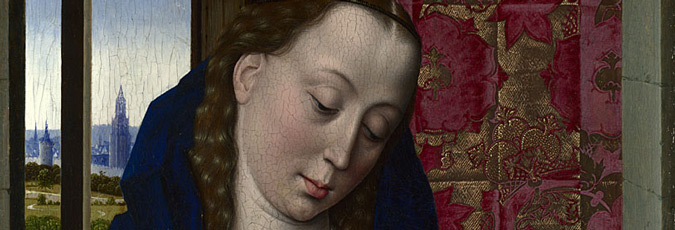A fully-funded PhD studentship in partnership with the University of York
Collaborative Doctoral Partnership
The National Gallery offers a small number of Collaborative Doctoral Partnership studentships, funded by the Arts and Humanities Research Council (AHRC) and run in partnership with higher education institutions. These studentships focus on specific themes relevant to the Gallery's collection and wider research themes.
Research project
This project takes the Bouts-workshop painting 'St Luke Drawing the Virgin and Child', which will form the heart of an exhibition opening at York Art Gallery in Autumn 2019, as a starting point for investigating how and why early Netherlandish artists formulated varying contexts for figural subjects. These settings ranged widely from entirely abstract grounds (blank or patterned), to cloth backdrops, to dividing balustrades, to glimpses of a room corner, to more detailed interiors with or without exterior views, to outdoors (whether landscape or cityscape, entirely open or within garden walls).
Recent scholarship has investigated the spatial and conceptual relationships between the separate panels of diptychs and triptychs, while other studies have examined the iconographic significance of particular types of settings such as landscape or domestic interiors, but there has been no systematic study of how the wide range of possible settings in early Netherlandish paintings affected artists’ creative processes and viewers’ interpretive experiences. This project will focus primarily on portraiture and on depictions of the Virgin (which constitute a large proportion of early Netherlandish paintings, including those in the National Gallery’s collections) to examine the stark contrasts in effect between fully abstract grounds vs extensively articulated interiors, as well as the more subtle variations arising from different forms of depicted spaces.
Starting from the premise that the meanings of figures and their settings are inextricably interconnected, the project as a whole will question how settings may have affected figural design, and how settings were, in turn, adapted to suit figures; how the function of panels, or the requirements of particular patrons, may have affected the choice of setting; how different settings might alter a viewer’s experience of the same subject; how settings contribute to iconography and meaning of both secular and sacred figures; and whether consistent patterns in selection or design of settings can be detected within or between workshops in the period c. 1425–1525.

